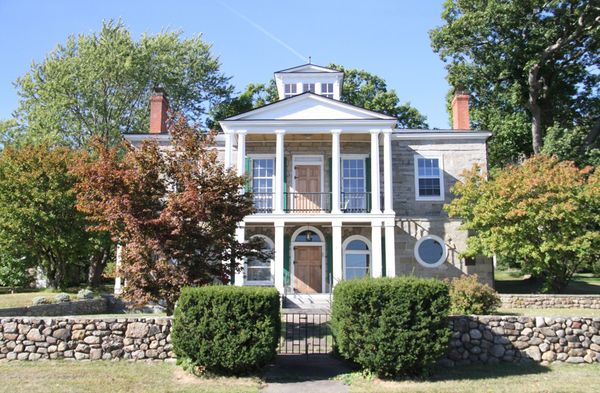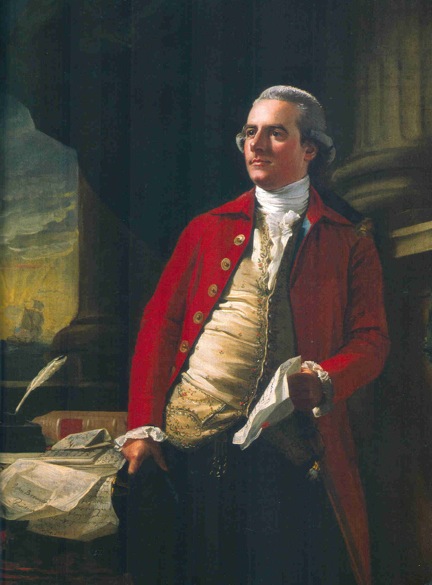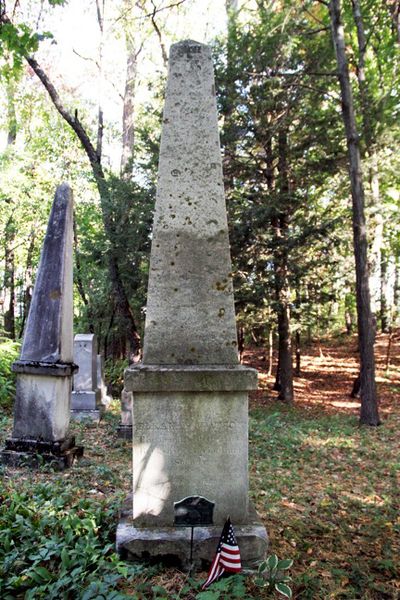STORIES FROM THE ATTIC: Elkanah Watson House, symbol of a growing nation

Elkanah Watson House, Port Kent (Provided photo — Andy Flynn)
PORT KENT – There’s a mansion on a hill on Lake Champlain, built by a Pilgrim ancestor with a biblical name. He rubbed shoulders with Founding Fathers, promoted New York’s canal waters, and deserves to be in the National Agricultural Center Hall of Fame.
Elkanah Watson packed a lot of living into his 84 years. Born on Jan. 22, 1758 in Plymouth, Massachusetts, he died on Dec. 5, 1842 in Port Kent, New York. In between, he was a Revolutionary War patriot, banker in Albany, father of the county agricultural fair, entrepreneur and pen pal to the country’s first four presidents. As the fledgling United States was growing as a nation, he was one of the energetic men who helped make New York the Empire State.
“He’s probably the most important person to ever settle in the Adirondacks that nobody has ever heard of, or few people have heard of, and he has three or four different lives before he comes to Port Kent to help found and settle this village,” said Adirondack Architectural Heritage Executive Director Steven Engelhart.
With other local businessmen, Watson helped establish a wharf at Port Kent in the early 1820s, naming the settlement after New York’s Chancellor James Kent. Soon steamboats from Burlington, Vermont were making regular stops at Port Kent, where the startup village blossomed into a commercial hub for the nearby iron-mining and manufacturing communities of Keeseville, AuSable Forks and Birmingham Falls (Ausable Chasm). By 1828, Watson had built his mansion on a hill in Port Kent.
“I suspect he came here because there were opportunities here,” Engelhart said. “The house that he built was on 5,000 acres that he owned here. He comes here with at least one of his other sons and they set about laying out this village. It’s located on Lake Champlain, and by 1828 the Champlain Canal has connected Lake Champlain to the whole Hudson River system to the south. I think they must know there are great economic opportunities for being involved in commerce along Lake Champlain.”

This Elkanah Watson portrait from 1782 by John Singleton Copley was donated to the Princeton University Art Museum by the estate of Josephine Thomson Swann. (Photo courtesy of the Princeton University Art Museum)
It was here that U.S. President Martin Van Buren spent the night during a trip to Plattsburgh in August 1839, becoming one of Watson’s most famous house guests. That was 54 years after Watson spent two days at Mount Vernon, Virginia, learning about agriculture at George Washington’s estate.
“I think the Elkanah Watson House is a really grand and unexpected surprise here,” Engelhart said. “It’s really unlike almost anything else that you can find in the Adirondacks. In a large part, that’s because the idea for this kind of house comes from elsewhere. It’s something that Elkanah Watson brought with him from his vast experiences in the eastern United States and in Europe.”
At the age of 15, Watson began his career in 1773 as an apprentice to merchant John Brown in Providence, Rhode Island, and he spent much of the war making business trips for his employer, taking him to the southern states and Europe for the patriotic cause. He dined with Benjamin Franklin in Paris, traveled by boat on the canals of Belgium, toured the salt works in Liverpool and listened to the king of England’s speech recognizing that the former British colonies in America were now “free and independent states.”
“During the Revolutionary War, he is an emissary, bringing messages and money back and forth between the colonies and France,” Engelhart said. “In 1782, he delivers the final peace treaty between the United States and Great Britain, and he’s there in December of 1782 before George III on the throne, when George III declares for the first time, or acknowledges, that the United States is independent. So he’s right in the middle of things during that Revolutionary War period.”
After the war, Watson toured western Europe until December 1784, when he boarded a sloop bound for New York City. Traveling south, he stopped at Mount Vernon in January 1785, delivering letters and books to Gen. Washington.

Elkanah Watson grave in Port Kent (Provided photo — Andy Flynn)
“To have communed with such a man in the bosom of his family, I shall regard as one of the highest privileges, and most cherished incidents of my life,” Watson wrote in his memoirs, printed in 1856, titled “Men and Times of the Revolution, or Memoirs of Elkanah Watson.”
Watson then bought a 640-acre plantation on the Chowan River near Edenton, North Carolina, but didn’t stay there long. In 1789, he moved to Albany with his wife Rachel Smith. He worked for the Bank of Albany and then established the State Bank of Albany in 1803.
“Canals, roads, banking, education and business – none of these had escaped his interest or attention before he moved from Albany in 1807,” states the Elkanah Watson House’s 1978 inventory form for the National Register of Historic Places. “Moreover, he had also amassed a fortune.”
In 1807, Watson and his family moved to a farm in Pittsfield, Massachusetts, where he became one of the nation’s agricultural leaders.
“In 1810, he brings together a group of farmers and their livestock on the green … and this leads to the creation of the first agricultural or country fair in the United States,” Engelhart said. “The following year, he founds the Berkshire Agricultural Society, which then gets replicated all over the country, these organizations to help foster and promote good farming in the United States.”
Watson moved back to Albany in 1816 and continued to devote a large part of his time promoting agriculture, throwing his support behind the establishment of new agricultural societies, a state board of agriculture in New York and a national board of agriculture. He wrote to former U.S. presidents James Madison and Thomas Jefferson regarding the national board of agriculture idea, asking for their support. He also ramped up the promotion of an inland canal system in New York.
While traveling in Europe and America, Watson took notice of his surroundings – what worked well for business – and used those success stories to help his young nation grow. For example, he was impressed with the canal systems in Belgium, the Netherlands and England and saw how they helped the economy, getting agricultural and manufactured goods and raw materials to markets. He was influenced by what he saw on his trips and followed up with investments.
During a trip to New York’s interior in 1791, for example, Watson saw the salt works in the Syracuse area and envisioned that the salt would eventually find its way to markets using a canal system. He writes about this in his memoirs:
“It will enter Ontario, and other great lakes, and find its way down the St. Lawrence by Oswego, into Pennsylvania, and the Chesapeake, up Seneca river to the head of the Seneca lake, and by a portage (perhaps eventually a canal) of eighteen miles to Newtown, on the Susquehanna river; and through canals in contemplation, up Wood Creek and down the Mohawk river, into the Hudson.”
Watson speculated in land and bought property on the Tioughnioga River, where the east and west branches meet, at the village of Cortland and called his property Port Watson. He unsuccessfully lobbied the state to build a canal between Port Watson and Syracuse, which would have given his port a direct link to the salt works, shipping salt down the Tioughnioga River to the Chenango River, the Susquehanna and finally the Chesapeake Bay.
By the late 1820s, Watson was focused on establishing commerce at Port Kent on Lake Champlain, and he moved into his new mansion in 1828.
“The embellishment of his grounds, horticulture and agriculture principally occupied his time,” states his memoirs.
Watson once again turned to transportation, trying to link St. Lawrence County to Lake Champlain. He was a proponent of the Port Kent and Hopkinton Turnpike, which was constructed between 1829 and 1832 through some of the most remote parts of New York state. The road opened in 1833. Watson was also a proponent of a railroad from Ogdensburg to Boston.
“I love the kind of Renaissance man that he was,” Engelhart said. “He’s just all over the place, and he’s the kind of person I would have loved to have met because of his diverse interests and his great enthusiasm for everything that he seemed to touch.”
Watson is buried in the cemetery in Port Kent, a couple blocks away from his mansion, which is now a private residence.
“On his obelisk gravestone, the one thing that it says about him, carved in stone, is that he was the founder of the Berkshire Agricultural Society, indicating that was what the family or what he was the most proud of in his accomplishments,” Engelhart said.
As a patriot of the American Revolution, a dreamer and entrepreneur, Watson seemed to be the right person at the right time in history for the United States. He embodies the American Dream.
“If you think about this as being a really young country where anything was possible, he kind of acts that out,” Engelhart said. “And he is kind of a model for what you could do if you sort of set your mind and heart and shoulder to it.”
- This Elkanah Watson portrait from 1782 by John Singleton Copley was donated to the Princeton University Art Museum by the estate of Josephine Thomson Swann. (Photo courtesy of the Princeton University Art Museum)
- Elkanah Watson grave in Port Kent (Provided photo — Andy Flynn)



